CHAPTER SIXTEEN
The Lost Survivors from the Moon
On November 20, 1966, NASA’s Lunar Orbiter 2 was drifting twenty-nine miles above the Moon’s surface, over the Sea of Tranquility, when it captured a stunning image that rocked the Russian and American media and scientific communities. Eight huge towers of different heights appear to rise up off the Moon’s surface. Curiously, they all seem to have the form of an Egyptian obelisk. In London, Paris, and New York, large Egyptian obelisks are on public display, each commonly called Cleopatra’s Needle. The Washington Monument in America’s capital city is the largest version, standing at 555 feet tall. This height may well have been deliberately chosen for secret ceremonial purposes; 666 might have been too obvious for a statue that was intended to commemorate the masculine aspect of Lucifer.
Most people never stop to think how odd it is that the United States would honor its first president with a gigantic obelisk, symbolizing the Egyptian sky-god Osiris. Although I do not believe these gods were originally negative, in the occult tradition of the Cabal, Osiris and Isis represent the male and female aspects of Lucifer. Most people are also unaware that the Statue of Liberty is secretly meant to represent Isis, complete with the beams of light radiating from the top of her head, indicating that she has become ascended. It is important to point out that Cabal people believe they are “the just” and will ascend when this mass solar event takes place. They see everyone outside their group as “the wicked,” and believe this event will physically destroy them. They even contort quotes out of the Bible and believe that stealing our money is God taking from “the wicked” and giving to “the just.”
The Cabal members believe their strength is due to their selective combination and practice of a wide variety of secret mystery-school teachings from ancient cultures all over the world, including Babylonian, Egyptian, Celtic, and Sufi. Cabal members often refer to everyday people as “the profane.” They feel we are not worthy of learning the sacred Mysteries, as they are often called—with the first letter capitalized. They fear that if ordinary people gained access to the Mysteries and began practicing the teachings, they could develop ascended abilities and use them to hurt others, potentially becoming a great threat. The torch held by the Statue of Liberty secretly represents the “Sacred Fire of Antiquity,” the knowledge of the Mysteries, and the book she holds in her other hand contains the Mysteries themselves.
In 2011, two Arizona State University scientists openly proposed that we may find evidence of extraterrestrial settlements on the Moon. Universe Today carried the story and used a corrupted photo of the towers captured by Lunar Orbiter 2 at the top. The original 1966 photo was not damaged and was far more revealing, as we shall see. The corrupted photo has a sharp line running down the middle, right next to the tallest tower, which the original did not have. Furthermore, the black levels have been cranked up, making the shadows of the towers very difficult to see—unlike the original, where they were staggeringly obvious. Nonetheless, this announcement was a positive step forward, and may well have been part of the gradual disclosure process:
Two researchers at Arizona State University (ASU) have made a rather controversial proposal: have the public and other researchers study the high-resolution photographs of the Moon already being taken by the Lunar Reconnaissance Orbiter (LRO), to look for anomalies that may possibly be evidence of artifacts leftover from previous alien visitation. The theory is that if our solar system had been visited in the past, the Moon would have made an ideal base from which to study the Earth. . . .
Of course, it has been said by some that such artifacts have already been found and known about for decades but hidden from the public by NASA, et al. . . . There are actually a handful of anomalies from various missions that would be interesting to see at much higher resolution via LRO, such as the well-known “Blair Cuspids” photographed by Lunar Orbiter 2 in 1966. . . .71
This article did not take into account the fact that NASA deliberately airbrushes artifacts and UFOs out of their images before they release them to the public. They do not want us to see these anomalies with any detail—at least not until they feel it is advantageous for them to release the information. Therefore, we have to do the best we can in analyzing those few images that have managed to escape the ongoing censorship efforts that are in place.
Transparent Aluminum
It is astonishing to find Egyptian-style obelisks on the Moon, and we will survey much more of the evidence as this chapter goes on. This changes everything we thought we knew about ourselves, our lives on Earth, and the greater cosmos that surrounds us. Multiple insiders have confirmed that these obelisks and towers are made out of a clear glass-like material—as seen on the cover of the American edition of this book. The actual material has been analyzed and is an advanced, transparent aluminum alloy. Bruce first told me this in 2014, as part of his “authorized disclosure.” Just over a year later, a US Naval Research Laboratory scientist named Dr. Jas Sanghera announced his discovery—or perhaps his authorized release—of a transparent aluminum alloy. The existence of this material appears to have been deliberately leaked in the film Star Trek IV: The Voyage Home. In this article from Ubergizmo, the author reflects on his fondness for the movie and how fascinating it is that this material now exists in the “real world.”
It seems that transparent aluminum is as real as it gets today, thanks to US Naval Research Laboratory scientist Dr. Jas Sanghera who described it as “actually a mineral, it’s magnesium aluminate. The advantage is it’s so much tougher, stronger, harder than glass. It provides better protection in more hostile environments—so it can withstand sand and rain erosion.” . . . Should the cost come down in due time, then consumer applications will also benefit, including smartphones and watches.72
In this next quote from Total Security Solutions, the authors discuss how transparent aluminum works far better than current bulletproof glass. An armor-piercing bullet of .50-caliber size will travel three inches through bulletproof glass but can make it only half as far through transparent aluminum. Even better, transparent aluminum weighs half as much and needs to be only half as thick as traditional bulletproof-glass armor:
In addition, transparent aluminum armor can be produced in virtually any shape and can also hold up to the elements much better than traditional bulletproof glass, which can be worn away by blowing desert sand or shrapnel.73
This article also reveals that the US Navy is working on a version they call Spinel, while the military-industrial complex defense contractor Raytheon is producing their own version called ALON:
Developed by Raytheon, ALON begins as a powder, which is then molded and baked in very high heat. The heating process causes the powder to liquefy and cool quickly, leaving the molecules loosely arranged, as if still in liquid form. It is this crystalline structure that provides ALON its level of strength and scratch resistance comparable to rugged sapphire. Polishing the aluminum oxynitride strengthens the material and also makes it extremely clear.74
Almost every insider I have met has indicated that the major defense contractor firms are intimately involved with the UFO cover-up and reverse-engineering of technology. The gradual release of transparent aluminum into our society appears to be a further fulfillment of the prophecy of Ian’s physics professor. He had told us we would see stunning breakthroughs in materials science, creating compounds with geometric crystalline structures that were much more useful and powerful than anything we had ever seen before.
Transparent aluminum weighs very little. This means you can build elaborate structures with it without the risk of them falling over under their own weight. The transparency of the material would also allow you to create gigantic domes that would permit sunlight to pass through. The dome could then be pressurized with an atmosphere, thanks to the abundant water ice on the Moon. This would provide a safe and habitable area for people to live, providing it was given a radiation-proof coating. If the dome was thick enough, it would also create an impressive shield against enemy attacks, given that transparent aluminum is significantly more effective than bulletproof glass.
The towers in the Lunar Orbiter 2 image are extremely tall, extremely skinny, and have pointed tops, exactly as obelisks do.75 It is highly unlikely that any natural geological processes could have created such huge towers on the surface of the Moon. Millions of years of meteorite strikes should have pounded the life out of any natural feature that would poke that far above the horizon. There is a constant stream of particles and chunks of rock hitting the Moon, traveling at a very high speed, and their effect is much like a sandblaster. Yet, as we just read, transparent aluminum is extremely resistant to sandblasting. Unfortunately, Orbiter 2 was pointing straight down when the classic photo was taken, so we cannot see the sides of these objects. Nonetheless, the shadows they cast are remarkable—and have been subjected to extensive scientific analysis.
The Valley of Monuments
According to a Washington Post article on November 23, 1966, “The six shadows were hailed by scientists as one of the most unusual features of the moon ever photographed. . . . On seeing the picture, one scientist wanted to call the region the moon’s ‘Valley of Monuments.’ . . . Scientists said they have no idea what is casting the shadows. The largest shadow is just the sort that would be cast by something resembling the Washington Monument, while the smallest is the kind of shadow that might be cast by a Christmas tree.”76 NASA said the Sun was eleven degrees above the horizon, and therefore estimated the “largest protuberance” was approximately fifty feet wide at its base and between forty and seventy-five feet high.77

Original NASA Lunar Orbiter 2 Image LO2-61H3, Showing Lunar Obelisks
Boeing made the Lunar Orbiter 2 spacecraft that took the photo, and a Boeing anthropologist named William Blair openly stated that this image reminded him of an aerial survey map from a prehistoric archeological site. A Los Angeles Times article from February 1, 1967, quoted Blair as saying, “If such a complex of structures were photographed on earth, the archeologist’s first order of business would be to inspect and excavate test trenches and thus validate whether the prospective site has archeological significance.”78
Blair noticed that the towers had a curious geometric alignment, which looks like the stars in the belt of the constellation Orion to even the casual observer. The three main pyramids on the Giza plateau in Egypt are also built to perfectly match the positions and magnitudes of the stars in Orion’s belt, as Robert Bauval discovered in the mid-1990s. Since Egypt has obelisks that seem similar to whatever we are seeing on the Moon, this suggests the intriguing possibility that the people who built the Egyptian monuments may have also had bases on the Moon. Or the Egyptian settlers may have had records from survivors of a lost civilization that had lived on the Moon. These survivors may have even believed they were descended from ancient ancestors in the constellation Orion, and had traveled to our solar system from this nearby group of stars long ago.
Russian scientists created a detailed analysis of the obelisks’ geometry in the Technology for Youth publication. According to an article in Argosy magazine, “Soviet space engineer Alexander Abramov has come up with a rather startling geometrical analysis of the arrangement of these objects. By calculating the angles at which they appear to be set, he asserts that they constitute an ‘Egyptian triangle’ on the moon—a precise geometric configuration known in ancient Egypt as an abaka. ‘The distribution of these lunar objects,’ states Abravov, ‘is similar to the plan of the Egyptian pyramids constructed by Pharaohs Cheops, Chephren, and Menkaura at Gizeh, near Cairo. The centers of the spires in this lunar abaka are arranged in precisely the same way as the apices of the three great pyramids.’”79
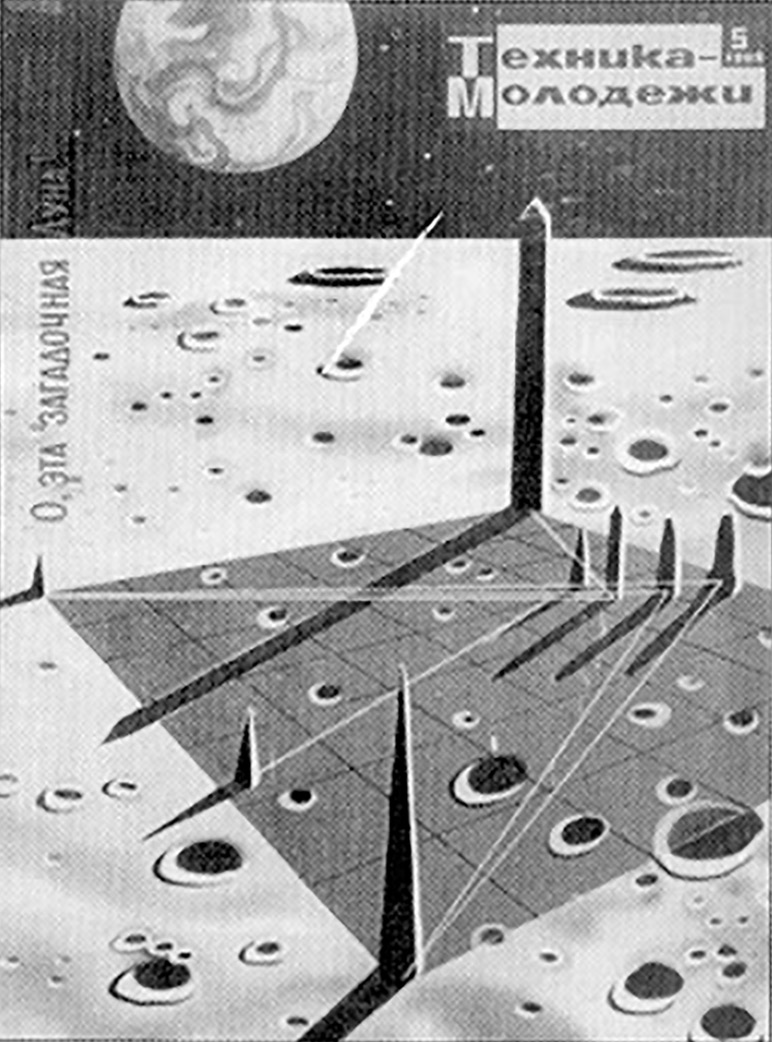
Russian Geometric Analysis of Lunar Obelisks in Technology for Youth magazine
The Collapsed Rectangle
Since the Moon has no atmosphere, you would either have to live inside a bulletproof structure or go underground. Otherwise you would be constantly pelted with rocks of different sizes, from micro-meteorites right on up through the much larger and more dangerous chunks that form craters once they crash-land. On Earth, most of these rocks burn up in our atmosphere as meteors before they ever hit the surface. On the Moon’s surface you would also be exposed to radiation from the Sun without the shield of an atmosphere to protect you. Transparent aluminum is difficult to manufacture in large quantities, and would also require an effective radiation-proof coating. Building a base below the surface would be much easier, comparatively speaking. This means we would end up seeing a large, hollow area, probably square or rectangular, below the surface. If such a structure were many thousands of years old, the roof would gradually be pounded in by meteorite strikes. Over time, the geometric structure of the room below the surface would become visible.
Remarkably, Blair noticed the Moon’s surface had collapsed in a highly artificial-looking rectangular shape right in the middle of all these towering spires. This suggests that we are seeing the remains of an ancient underground base whose roof had fallen in on itself.
According to the Los Angeles Times in a 1967 article, “The anthropologist also discovered in the photo, he says, what appears to be a large rectangular shaped depression or pit directly west of the largest spire, estimated to be as tall as 70 feet. Blair says the shadow cast by this depression seems to indicate four 90-degree angles and resembles the profile of an eroded pit structure.”80 Based on this evidence, Blair suggested these objects might indeed be artificial in origin81—but the whole thing was kept very quiet on any official level, just as our other NASA insiders reported in the previous chapter. After these exciting news articles came out, no one ever heard about it again.
The official NASA photo of this area has had the black levels cranked way up after its original release, making the shadows from the towers almost impossible to see, since they blend in with the background. There is also a very frustrating line in the middle of the official image that did not appear in the original photograph that was published widely at the time. This line cuts into the largest tower and further confuses the eye. Nonetheless, in the darkened image we can easily see not one but two rectangular depressions, positioned at ninety-degree angles to each other. These depressions are almost exactly the same size and shape, suggesting two different underground rooms that were built based on a common design.
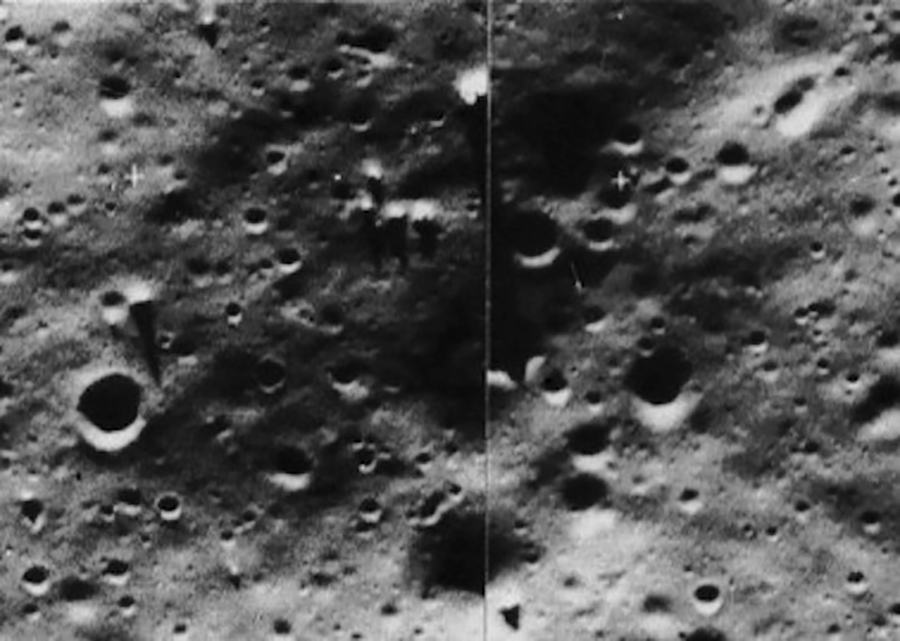
“Official” NASA Lunar Orbiter 2 Image of Lunar Obelisks, Showing Rectangular Pits
Dr. Mark Carlotto Discovers Multiple Rectangular Areas
In 2002, Dr. Mark J. Carlotto used a digital elevation model to conclude that the tallest spire was about fifty feet in height—far higher than anything we would expect to appear naturally on the Moon. Dr. Carlotto has thirty years’ experience in satellite remote sensing and digital image processing.82 Carlotto also created synthetic stereo images to get a three-dimensional view of the terrain: “Of particular interest is a large rectilinear depression adjacent to the objects. This depression appears to be the deepest part of a larger network of rectilinear collapses of the surface.”83 In simple terms, this means there could be a whole series of different rooms hiding below the surface of the Moon in this area. Over the course of thousands of years of meteorite strikes, the rooftops have gradually been pounded in, revealing some of the hidden geometry underneath.
Carlotto’s analysis reveals that the two main rectangular depressions we see are both about 100 to 150 meters in size, making them comfortably sized areas for a base that could house a small group of people. The tallest tower could be used to help ships come and go, just as we have in our own airports. Carlotto’s image processing techniques also pulled out an entire network of additional rooms that are not as visible to the naked eye. He uses the word “lineaments” to describe lines on the Moon’s surface that indicate the possibility of further underground rooms whose rooftops have fallen in since they were first built.
Carlotto concludes: “In summary, the key features that suggest that these objects and their surrounding terrain may be artificial in origin are: the presence of multiple objects, conical or pyramidal in shape, that do not appear to be typical rocks or outcroppings; perpendicular alignments between five of the seven objects; a network of rectangular collapses of the surface; horizontal and vertical lineaments (and) correlations in alignments between these objects, the orientation of the rectangular depression, and the direction of lineaments.”84
It is also intriguing to note that this area is only three hundred kilometers northwest of where Apollo 11 landed, which means the Apollo astronauts could have easily gotten a closer look at the towering objects as they flew in. A fifty-foot-tall obelisk would have been easy to spot while orbiting at a low altitude. The astronauts may also have been able to view it from the ground, such as with a telescope, and possibly could have used the rover to drive in for a slightly closer look—though it is unlikely they would have had enough power to drive three hundred kilometers, which would be a 186.4-mile trip each way. The rover’s maximum traveling speed was only eight miles per hour, and there were many obstacles that prevented it from driving in straight-lined paths. Harrison Schmitt was probably well aware of the Blair Cuspids when he designed his “Stonehenge” patches for NASA’s Apollo 17 mission. In order to become an Apollo astronaut, he would have had to go through classified briefings and be sworn to secrecy about what he was told. These photographs, and an explanation of what they might be looking at, could easily have been part of Schmitt’s briefing.
The Mysteries of Frame 4822
An even more impressive piece of evidence we have for Chatelain’s “mysterious geometric structures of unknown origin on the Moon” was discovered by Richard C. Hoagland. In 1995, Hoagland was going through the official catalog of Apollo 10 photographs when he noticed that one frame, AS10-32-4822, was completely black. Most people would naturally assume this was caused by a camera malfunction, but Hoagland wondered if something interesting was being hidden. He ordered the 4822 frame from the National Space Science Data Center (NSSDC) at Goddard Space Center, and much to his surprise, the negative he received in the mail was not blacked out at all.

A Series of Geometric Structures on NSSDC Frame 4822. Far Right in Ken Johnston Version Cut Out of “Official” Version
The first thing Hoagland noticed was a small square crater off to the left. In this case, it looked as if someone had cut a perfect square area out of a hill. Nature doesn’t make squares like this, and this area could have been built by people who wanted to have protective walls around their base, and then perhaps had used transparent aluminum for the rooftop. As Hoagland continued inspecting this area, he realized there was another, slightly smaller square crater to the northeast of the first one. Then, directly above these artificial-looking craters, he saw what may have been an entire row of squared-off buildings. In this case, it appeared that their rooftops had not collapsed in, but had become covered with Moon dust over many thousands of years. Each roof had the hint of a four-sided shape—as if they were originally given transparent-aluminum rooftops with a wide, shallow pyramid structure.
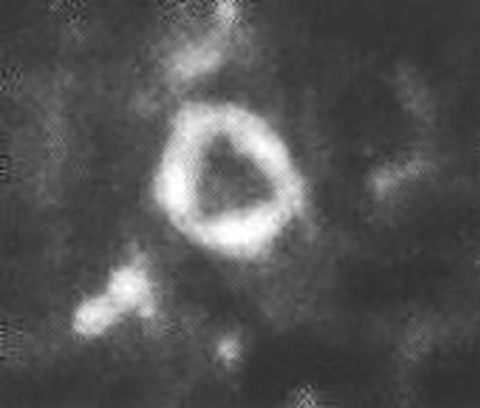
NASA Image of the Ukert Crater, Showing Degraded but Symmetrical Triangular Formation
This series of structures appears directly next to the Ukert crater, which is also highly bizarre in its own right. The inside of the crater has a black triangular shape that is remarkably symmetrical—very close to an equilateral triangle. This could also be the result of artificial construction. The shape is no longer sharp and distinct, with the sides of the triangle being somewhat rounded, but this could be the result of prolonged erosion from meteorite hits. The triangular shape would make it easy for people piloting spacecraft to identify their landing area, just as conventional pilots look for a runway. There may well be ancient corridors linking this “cosmic parking lot” to the row of buildings that appear to have been constructed right next door.
The Castle
The most stunning formation in this same image was a short distance over on the right-hand side, near the Manilius crater. Hoagland dubbed it “the Castle,” and it is unbelievably impressive. If you were to show this picture to anyone without telling them where it was from, and ask them what it was, they would say it was an aerial picture of a geometric building—perhaps a military base. We see a series of long buildings, parallel to one another, intersecting at perfect ninety-degree angles and forming an overall triangular shape from the overhead view.
4822 Is Quite Popular
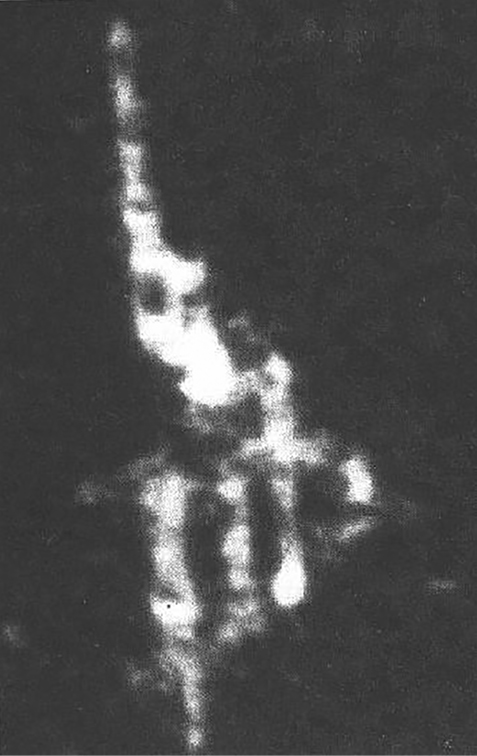
Close-up of Apollo 10 Frame AS10-32-4822
Hoagland publicized this image in a small, private newsletter. One of his readers, amateur astronomer Alex Cook, subsequently ordered his own negative of frame 4822 from NSSDC, and developed it in his college photo lab. Surprisingly, he received a different photographic angle of the same area than what Hoagland had gotten. This image was taken perhaps a second or two after the first. Cook continued ordering copies of 4822, and to his shock, ultimately ten different camera angles of this same area were sent to him—all filed under 4822. Hoagland concluded that the number 4822 was used as a code so that insiders could easily order copies of these images, but most people would never think to go looking for them. If a normal civilian asked for a copy of frame 4822, the archivist would release only the blacked-out version. However, after twenty-plus years had gone by, the current archivist apparently didn’t know or remember the protocol, and just quickly grabbed whatever came up first as 4822 in the master file.
Hoagland realized that Apollo 10 astronauts Eugene Cernan and Thomas P. Stafford were probably ordered to take multiple seventy-millimeter Hasselblad film images of this area as they went by with their handheld camera. This is the same film now used for IMAX. By doing so, they could create a rudimentary animated movie of the base—complete with stereo images to bring out the three-dimensional depth. When Hoagland visited the NSSDC and asked to see the original of frame 4822, he was told that they couldn’t find the negatives, as they had been “stolen.” Much more detail can be found in Richard Hoagland and Mike Bara’s New York Times bestselling book Dark Mission.85
Ken Johnston Finds Another 4822
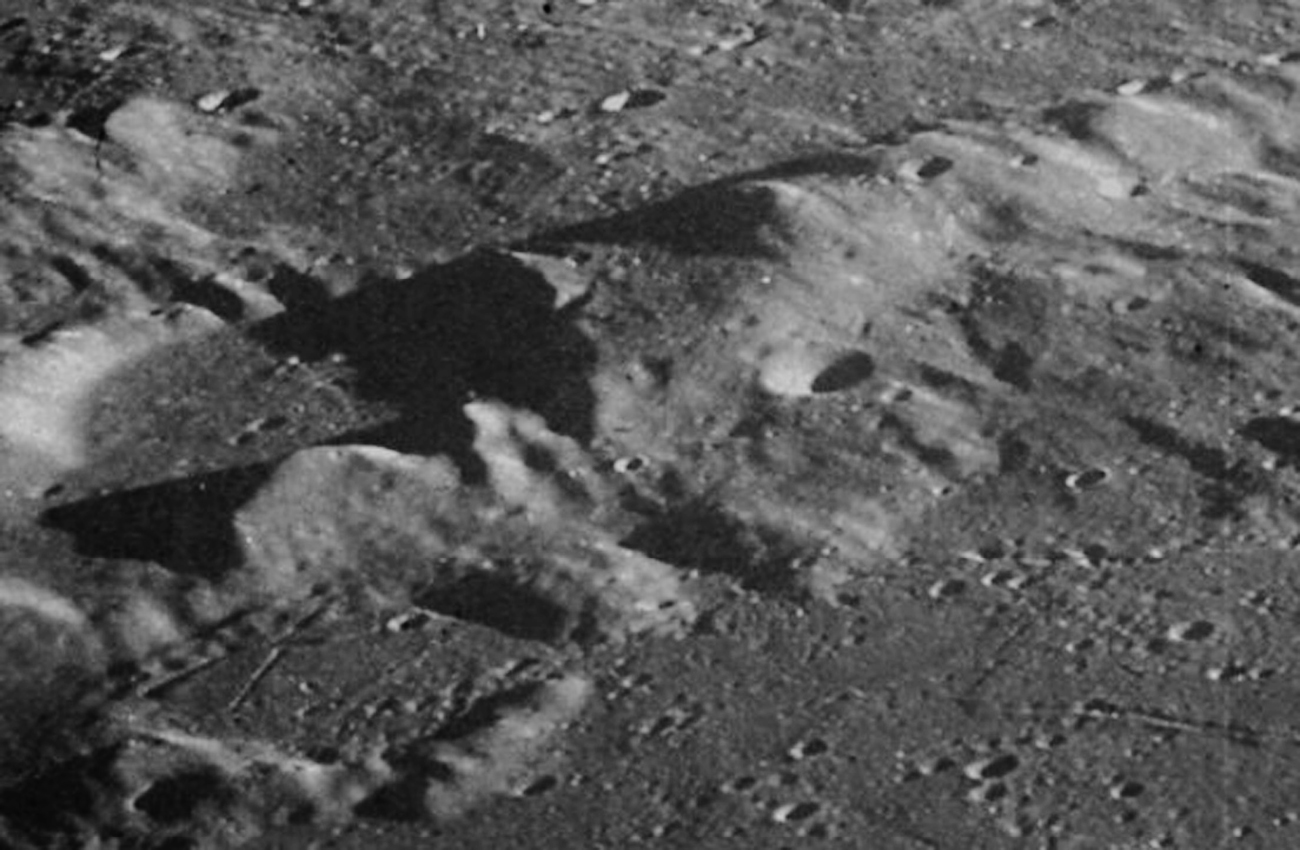
Additional Detail from Apollo 10 Frame AS10-32-4822
Hoagland’s work took another quantum leap forward with the introduction of Ken Johnston. This was another development that took place just a few months after I first got online. On March 21, 1996, Hoagland gave a long-anticipated press conference in Washington, DC, at the National Press Club. A number of major media organizations were present, including C-SPAN, USA Today, the Associated Press, and the New York Times. Sadly, the audience was very hostile, and when Hoagland brought up information he had already revealed in the past, he was shouted at and asked if there was anything new. What happened next was reported by Michael Lindemann of CNI News.
Hoagland made good on his promise to bring in several other credible spokesmen to discuss the evidence for moon anomalies. Chief among these was former NASA and Boeing aerospace engineer Ken Johnston, who worked with NASA executive Dr. Thornton Page during the years of the Apollo moon missions. Johnston said that he had seen photo evidence, including some 16mm movie footage, that convinced him there was something anomalous on the moon. He said that he and Thornton Page were the first people to view 16mm film from the Apollo 14 mission that showed 5 or 6 lights in a crater on the dark side of the moon, as well as a strange plume of smoke. Johnston said he showed the movie footage to other NASA personnel the next day, but when he got to the point where he had seen the lights in the crater, those frames seemed to be missing. Johnston asked Page about the missing footage, and Page said, “I don’t know what you’re talking about.” Johnston is convinced the footage was taken out and either hidden or destroyed.86
Johnston was ordered to destroy many original copies of Apollo Moon images, but he saved a full set of them in Oklahoma City, within a university library archive. We are all very fortunate that Johnston did not destroy all the originals in the archive. NASA did not want any of these images getting out to the public—at least not unless they had been doctored. The most stunning discovery out of Johnston’s original imagery was found on the Apollo 10 photograph AS10-32-4822. This was yet another photograph hidden away under the “4822” code number. NASA is supposed to give each photograph a different number, but this was not the case with 4822. In a photograph shown at the press club, we see an image on the left that is from the official NASA archive at Goddard Space Flight Center. The image on the right is from Ken Johnston’s own original that came from the Johnson Space Center. The difference is remarkable. Ken Johnston’s original clearly shows a bright white dome, shaped like the tip of a bullet, sitting on a hilltop. The dome is perfectly symmetrical, and is so bright that it appears as if light is reflecting off it.87 The official image has had all traces of the dome conveniently removed.
Russian Media Publicity Explosion

Enterprise Mission Comparison of Goddard (L) and Houston (R) “4822” Images, Showing Reflective Dome
In 2007, I coauthored a two-part paper with Hoagland that features a wealth of NASA photographs of the Moon with strikingly artificial-looking objects in them. The article was written to celebrate the fact that the Russian media gave Hoagland’s latest press conference a significant amount of favorable coverage. A variety of color images are included in the article that do not translate well to a black-and-white printed book, so I encourage you to go take a look at it on Hoagland’s website, EnterpriseMission.com.88 Hoagland was able to compare two different NASA images of the same area—AS14-66-9301, in which astronaut Edgar Mitchell is pictured, and AS14-66-9279, which is taken of the same area but is just a few feet over to the right. In the second image, the leg of the lunar lander is visible and Mitchell is no longer in the shot. Hoagland was also able to find an original version of AS14-66-9301 in Ken Johnston’s archive, and it had much clearer detail than what we see in the official version.
Taken together, these images reveal a stunning array of glass-like ruins right behind where astronaut Mitchell was standing. Since this material is almost completely transparent, it was nearly invisible in the photo, but with some simple Photoshop adjustments, remarkable details emerge. There appears to be a structure made of three primary pillars in the middle of the image. It also appears that a series of glass-like reflections are occurring inside. I was greatly surprised when these images came out and was happy to lend my efforts to Hoagland’s campaign. The Russians did their own digging and found three new examples of photos that had obvious signs of tampering.
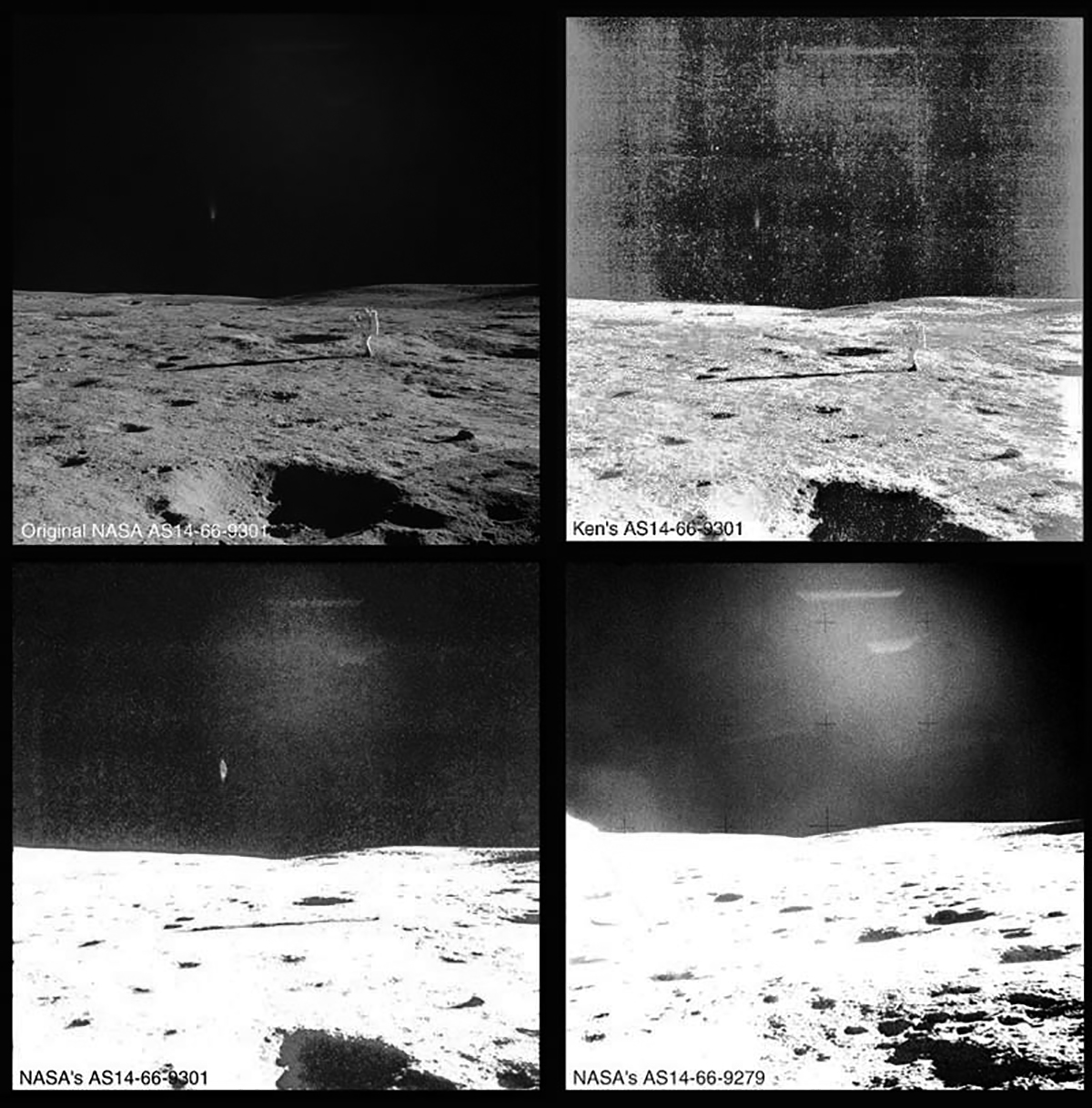
Enterprise Mission Comparison of Versions of AS14-66-9301 and AS14-66-9279, Showing a Matrix of Glass-like Ruins
The most stunning image discovered by the Russians was GPN -2000-001137. In our article, we posted a direct link to the original on the Great Images in NASA, or GRIN, website, which is an official NASA resource. When you download the image, all you appear to see is a NASA astronaut posing next to an American flag, with a jet-black background behind him. A pale image of the Earth is visible in the background, adding a dramatic flair. The image is still accessible on NASA’s website at the time of this writing.89 By doing a simple enhancement of the image in Photoshop, the Russians were clearly able to demonstrate that the area around the Apollo astronaut had been deliberately airbrushed black. This is almost completely invisible to the naked eye and is only detectable with advanced image-processing software.

Airbrushing around Apollo 17 Astronaut Harrison Schmitt
The strangest thing about the airbrushing is how geometric it is. It begins at the top left, above the astronaut’s head, with a horizontal line. It then drops straight down, forming a square. Then a triangular area is airbrushed out immediately next to it, with the bottom of the triangle touching the top of the astronaut’s head. Another area projects out from the front of the astronaut’s helmet. Skeptics may argue that this was a simple fix to eliminate glare coming off the astronaut’s suit, and that may be possible, but it may also be hiding a large object. The next image found by the Russians, 2000-001131, reveals obvious lines where material has been cut out of additional copies of the same photograph with a razor blade and then glued on top of the original. This again suggests there was something very large behind the astronaut in the image that they were covering over, just as Donna Hare had indicated. Since the lines in this shot are too fine to translate to print, I again invite you to visit “Russian Media Publicity Explosion” online and see it for yourself.90
The “Solar Panel”
Now we will return to our original frame 4822, in which we see squared-off areas next to the Ukert crater on the left, and the stunningly geometric “city” on the right. Our “Russian Media” paper included another peculiar image from this same shot, which looks, to me, like a giant solar panel.91 Whatever it is, it clearly appears to be technological and is by no means a natural formation. This may have been used to generate energy or radio communications for the nearby bases.
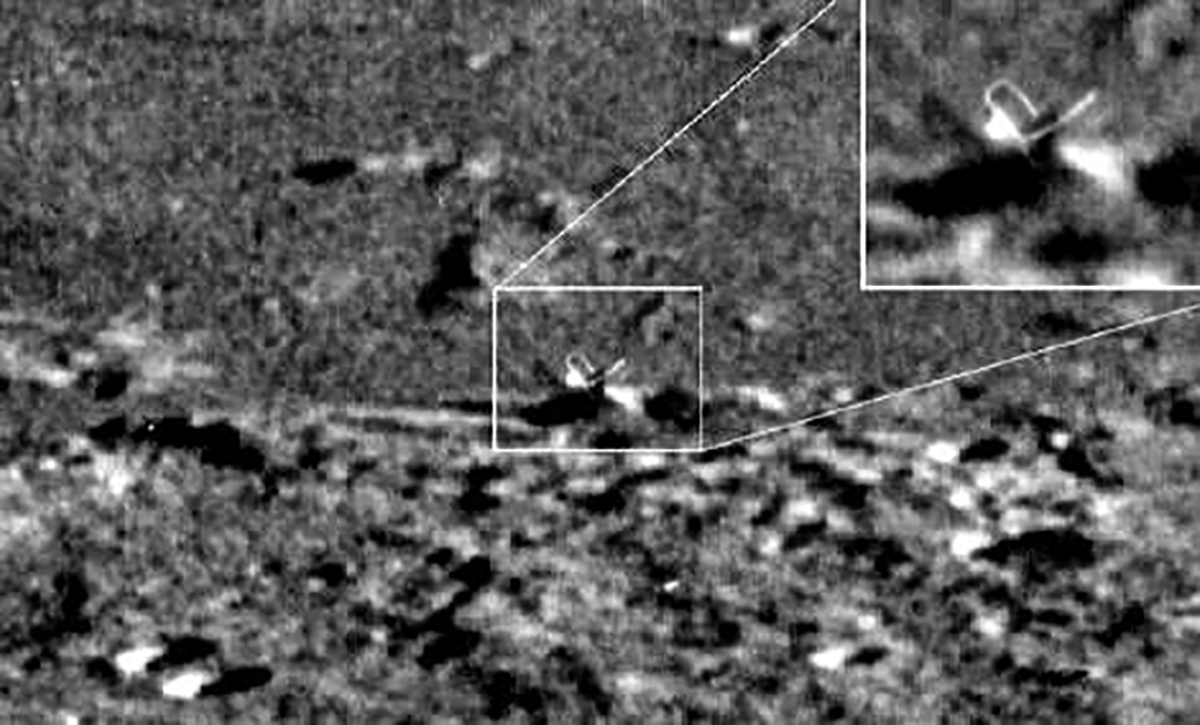
The “Solar Panel” from NASA’s “Missing” Frame 4822
The Stunning Russian Images from Zond 3
For me, the single most impressive images of all are also some of the oldest. The Russians were the first to officially launch a probe into space with Sputnik, on October 4, 1957. Two years later in 1959, they launched Luna 3, which reached the Moon on October 7 and broadcast until the twenty-second, at which time contact was lost. Seventeen low-quality images were produced, giving humanity our first view of the dark side of the Moon. The Russians followed up with Zond 3, which was originally intended to be able to orbit Mars. Zond 3 was launched on July 18, 1965, and made it to the Moon thirty-three hours later. The Russians focused their initial efforts on capturing the final 30 percent of the dark side of the Moon that Luna 3 had missed. The camera was programmed to take one picture every two minutes and fourteen seconds, for a combined total of twenty-eight images in one hour and eight minutes.
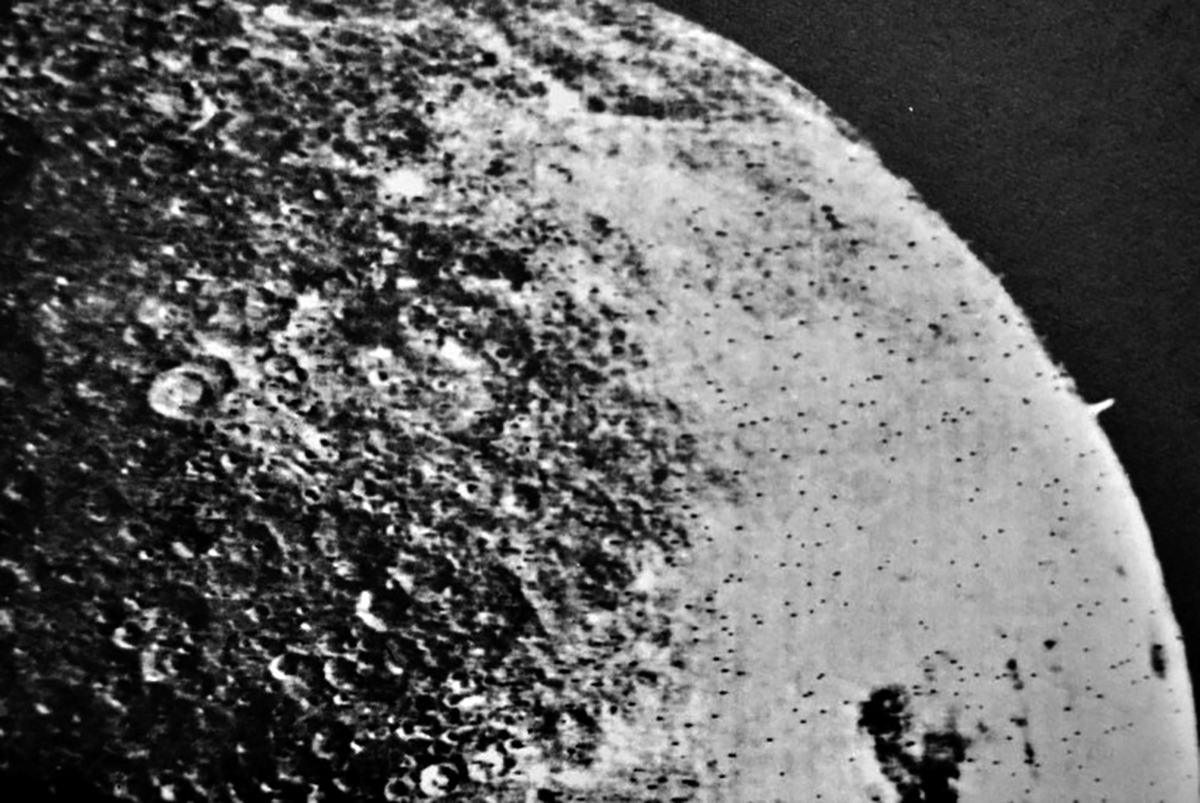
Gigantic Tower on the Dark Side of the Moon in Russian Zond 3 Image
The investigative website Ancient Code reveals what happened next: “In one of the images of the far side of the moon, a mysterious tower-shaped structure can clearly be seen protruding from the lunar surface. In its vicinity, no other similar structures are seen, and Ufologists believe that the mysterious ‘tower’ seen in the Zond 3 image is a crucial piece of evidence supporting their theory that there are alien structures on the far side of Earth’s moon. The image of the Tower on the moon was obtained on 20 July 1965. . . . At the time, the probe was about 10,000 kilometers above the Moon.”92
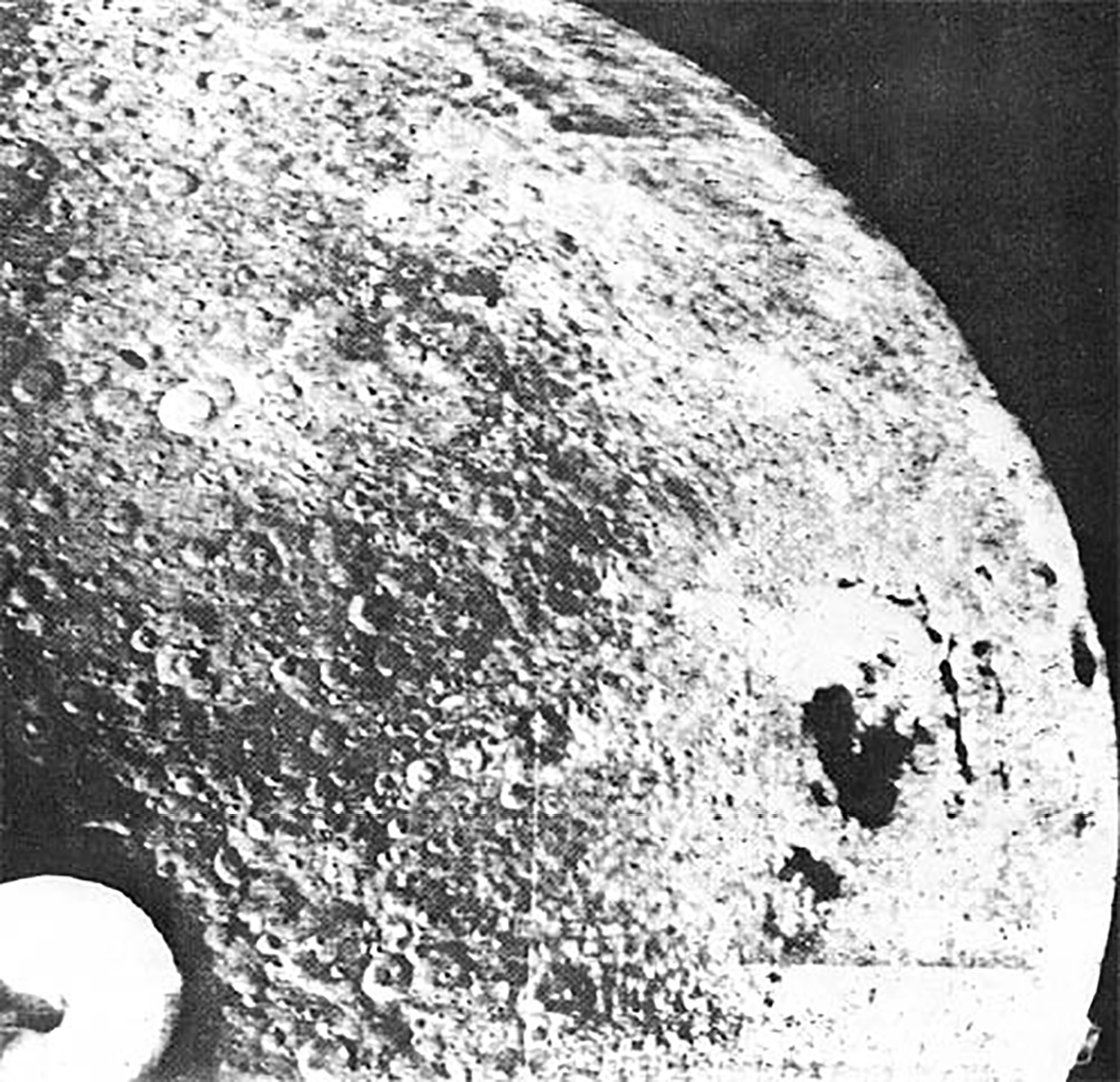
Gigantic “Glass” Dome on the Dark Side of the Moon in Russian Zond 3 Image (bottom right)
There is a stunningly obvious, symmetrical, bright white tower rising up from the surface of the Moon in the image, which was taken early in Zond 3’s sequence. The tower is perfectly perpendicular to the Moon’s surface, suggesting it is a genuine structure and not a photographic defect. Based on the size and curvature of the Moon’s surface, Hoagland has estimated this tower to be a staggering twenty miles in height. The bright white glow again suggests a transparent-aluminum structure that is capturing and reflecting the sunlight. This does not appear to be the result of a “camera malfunction,” a “stain on the lens,” a “photographic defect,” or “noise,” as skeptics have attempted to claim.
What most people fail to realize is that just a few minutes later, Zond 3 captured another equally stunning image from the same area. The Moon had now rotated enough that the tower was no longer on the horizon and thus is not visible. We can easily see the same craters that were in the previous photo, and we can also see a massive dome on the horizon that is farther south, capturing the sunlight. There are two clearly geometric lines of glass-like material that both rise from the lunar surface at the same steep slope before leveling off to a flat top. The ceiling of the dome is parallel to the Moon’s surface, as we would expect if it were a genuine artificial construct and not just a camera glitch. When you have two geometric sides with the same slope angle and height, and which connect to a flat top parallel to the surface, you have the structure of a flat-topped pyramid, or mastaba. Since this structure appears to be made out of transparent aluminum, we can see through it when the sunlight is catching it at this angle. There is also a thicker area in the exact middle of the dome, suggesting the presence of two additional geometric edges, thus making it a true four-sided pyramid-type object, just like a mastaba. Again, the size of this pyramid-like dome must be absolutely colossal—perhaps twenty miles in height. Skeptics have tried to say that it is merely the result of inferior Russian technology not being able to stitch the space probe’s images together properly, but this seems highly unlikely when we consider the overall weight of evidence.
Both of these mysterious images appeared quite close to each other, just a few frames apart, on a side of the Moon that normally never faces the Earth. If there are extraterrestrial or classified human bases there, they could be building far more elaborate structures on the dark side of the Moon and no one would see them. Indeed, one of my top insiders, Pete Peterson, has been told by Russian intelligence that the back side of the Moon now looks like Manhattan at night from a satellite view. There are stationary and moving lights all over, and it is literally teeming with activity. This again may seem impossible to believe. If this information does become widely known, all of us will have quite the “learning curve” and psycho-emotional adjustment to go through in order to integrate this new information into what we thought we knew.

Close-up of Gigantic “Glass” Dome on the Dark Side of the Moon in Russian Zond 3 Image
With a transparent-aluminum dome like this, people could live on the surface of the Moon, breathe a normal atmosphere, see the Sun, grow plants, and have a nice civilization inside. They could have buildings, roads, and even rivers and lakes by melting the abundance of water ice that can be found. Plants and animals could be selectively taken from a planet like Earth and brought in. The flat-topped pyramid shape would enhance the health of everyone inside, as I have argued in The Source Field Investigations. We will review some of that data as we go on. A pyramid-shaped roof of such colossal size would also be visually stunning for the people living inside, giving it a sense of spiritual significance. Others may wish to live under the surface for greater protection from attacks, a more climate-controlled environment, or perhaps because they didn’t have enough money or status to be able to live in the lush, outdoorsy atmosphere created in the domes.
They Had to Come from Somewhere
Although this is fascinating data, we still haven’t answered the question of how these people ended up trying to survive on the surface of the Moon in the first place. Why would they try to grow plants and live their lives under glass domes on such an inhospitable sphere? This is not a place where a civilization would naturally evolve. This is a group that clearly would have migrated there from somewhere else and used advanced technology in order to make it livable. Were they at war with a group that considered a healthier, happier place like the Earth to be their own exclusive, protected territory? Where did these lunar colonists come from originally? This question ultimately forces us to reconstruct the history of our solar system—which begins with something the insiders call the “Ancient Builder Race.” In order to set up the story of the Ancient Builder Race, it is first necessary to reveal the big picture of what the highest-level insiders shared with me. Only then will the full scope of the story be something we can appreciate.